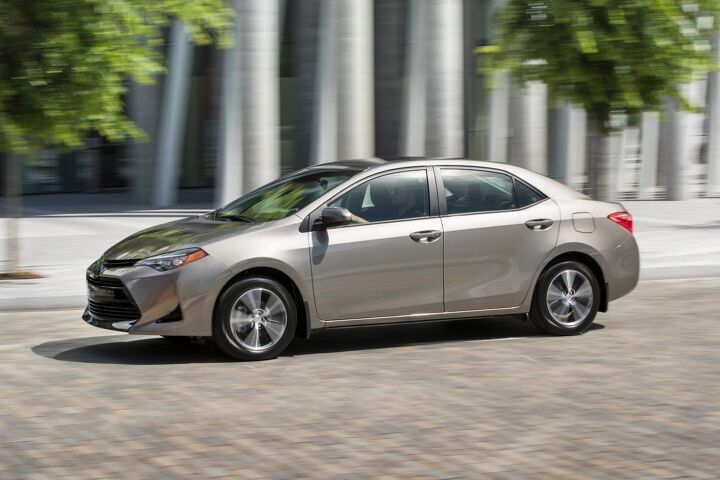Airbag, Seatbelt Fears Lead to 3.4-million-vehicle Toyota Recall

A ghost in the machine that could render passive safety systems like airbags and seatbelt pretensioners useless has infected a range of Toyota models, sparking a global recall of roughly 3.4 million vehicles — some 2,891,976 of those in the United States.
While the suspected fault only rears its head in certain types of crashes, owners would probably prefer their airbags deploy in all major impacts.
According to Toyota, the recall affects the 2011-2019 Corolla, 2011-2013 Matrix, 2012-2018 Avalon, and 2013-2018 Avalon Hybrid. Blame mixed signals for the recall.
The automaker says the affected vehicles “may be equipped with an electronic control unit (ECU) from a specific supplier designed to receive signals from crash sensors and deploy the airbags and seat belt pretensioners. “
“The ECU may not have adequate protection against certain electrical noise that can occur in certain crashes, such as severe underride crashes,” Toyota stated. “This can lead to incomplete or nondeployment of the airbags and/or seat belt pretensioners.”
It goes without saying that having both of these features working properly will greatly improve your odds of surviving a crash.
The remedy, Toyota claims, is a noise filter placed between the airbag control module and wire harness. An inspection will first determine whether a recalled vehicle needs the filter at all. Owners should be notified of the no-cost remedy by mid-March.
According to documents posted by the National Highway Traffic Safety Administration, “Toyota is unable to provide an estimate for the percentage of vehicles estimated to contain the defect.” While the fault has been determined to occur only in very specific circumstances (crashes where there is significant engine compartment intrusion before significant deceleration), the NHTSA stated that Toyota “is unable to estimate the likelihood for this to occur in the real world.”
Attempts to replicate the fault in testing have proven inconclusive. One potential real-world example of the fault occured in May of 2018, when a Corolla’s airbags failed to deploy following a frontal collision in California. However, supplier ZF-TRW was unable to download data from the ECU.
[Image: Toyota]

More by Steph Willems
Latest Car Reviews
Read moreLatest Product Reviews
Read moreRecent Comments
- El scotto UH, more parking and a building that was designed for CAT 5 cable at the new place?
- Ajla Maybe drag radials? 🤔
- FreedMike Apparently this car, which doesn't comply to U.S. regs, is in Nogales, Mexico. What could possibly go wrong with this transaction?
- El scotto Under NAFTA II or the USMCA basically the US and Canada do all the designing, planning, and high tech work and high skilled work. Mexico does all the medium-skilled work.Your favorite vehicle that has an Assembled in Mexico label may actually cross the border several times. High tech stuff is installed in the US, medium tech stuff gets done in Mexico, then the vehicle goes back across the border for more high tech stuff the back to Mexico for some nuts n bolts stuff.All of the vehicle manufacturers pass parts and vehicles between factories and countries. It's thought out, it's planned, it's coordinated and they all do it.Northern Mexico consists of a few big towns controlled by a few families. Those families already have deals with Texan and American companies that can truck their products back and forth over the border. The Chinese are the last to show up at the party. They're getting the worst land, the worst factories, and the worst employees. All the good stuff and people have been taken care of in the above paragraph.Lastly, the Chinese will have to make their parts in Mexico or the US or Canada. If not, they have to pay tariffs. High tariffs. It's all for one and one for all under the USMCA.Now evil El Scotto is thinking of the fusion of Chinese and Mexican cuisine and some darn good beer.
- FreedMike I care SO deeply!

































Comments
Join the conversation
Well, Takata's a gift that just keeps on giving.
We have had repairs completed for two recalls on our 2013 Corolla -- one for the Takata airbag, and the second (in the beginning of July 2020) for the noise filter. After the second fix, we experienced the strange occurrence of the "seat belt not fastened" indicator (for the passenger side) lighting up, as well as that of the "airbag off" light. (The SRS airbag symbol to the left of the tachometer would also light up.) The car would go a few days without this occurring, and then out of the blue, the indicators would light up. Dealer couldn't recreate the condition, nor did the ECU show that there had been a problem. We finally brought the car in while the indicators were flashing. We were told that the diagnostic code indicated that it was the "seat belt pretensioner". They had to contact Toyota to see if this fix was covered(!). We had an appointment scheduled for when they first expected the part to be available. We went in, they said that their computer inventory said it was there, but it was not. Unfortunately, whatever part is necessary is out-of-stock and on back order, with no idea of when it will be available. Meanwhile, I'm being chauffeured for almost two months, because I can't sit in the front passenger seat.